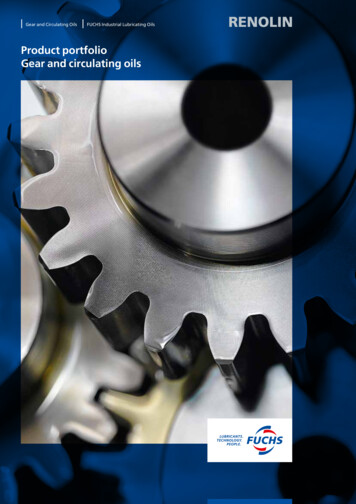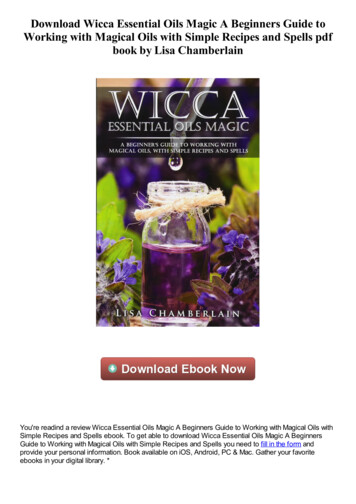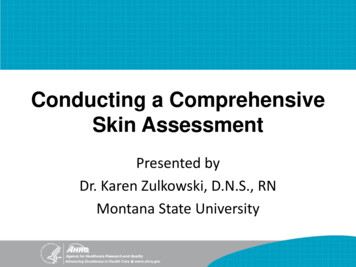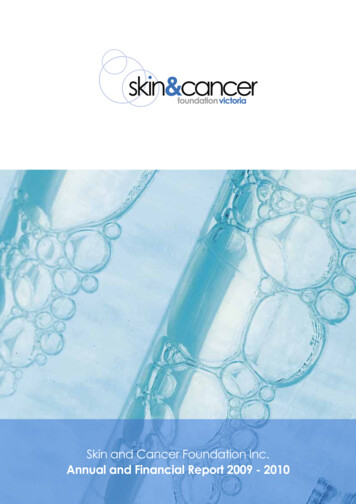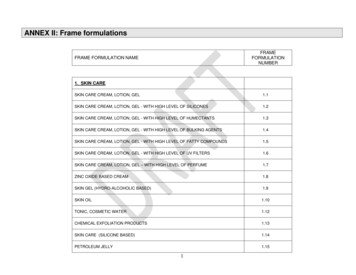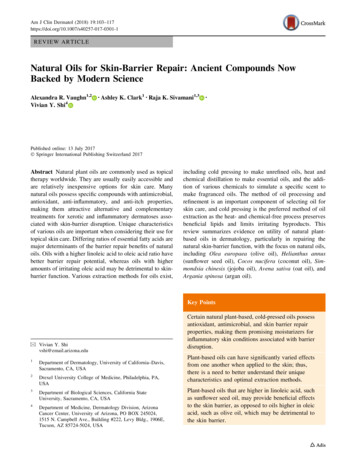
Transcription
Am J Clin Dermatol (2018) 1-1REVIEW ARTICLENatural Oils for Skin-Barrier Repair: Ancient Compounds NowBacked by Modern ScienceAlexandra R. Vaughn1,2Vivian Y. Shi4 Ashley K. Clark1 Raja K. Sivamani1,3 Published online: 13 July 2017Ó Springer International Publishing Switzerland 2017Abstract Natural plant oils are commonly used as topicaltherapy worldwide. They are usually easily accessible andare relatively inexpensive options for skin care. Manynatural oils possess specific compounds with antimicrobial,antioxidant, anti-inflammatory, and anti-itch properties,making them attractive alternative and complementarytreatments for xerotic and inflammatory dermatoses associated with skin-barrier disruption. Unique characteristicsof various oils are important when considering their use fortopical skin care. Differing ratios of essential fatty acids aremajor determinants of the barrier repair benefits of naturaloils. Oils with a higher linoleic acid to oleic acid ratio havebetter barrier repair potential, whereas oils with higheramounts of irritating oleic acid may be detrimental to skinbarrier function. Various extraction methods for oils exist,including cold pressing to make unrefined oils, heat andchemical distillation to make essential oils, and the addition of various chemicals to simulate a specific scent tomake fragranced oils. The method of oil processing andrefinement is an important component of selecting oil forskin care, and cold pressing is the preferred method of oilextraction as the heat- and chemical-free process preservesbeneficial lipids and limits irritating byproducts. Thisreview summarizes evidence on utility of natural plantbased oils in dermatology, particularly in repairing thenatural skin-barrier function, with the focus on natural oils,including Olea europaea (olive oil), Helianthus annus(sunflower seed oil), Cocos nucifera (coconut oil), Simmondsia chinesis (jojoba oil), Avena sativa (oat oil), andArgania spinosa (argan oil).Key Points& Vivian Y. Shivshi@email.arizona.edu1Department of Dermatology, University of California–Davis,Sacramento, CA, USA2Drexel University College of Medicine, Philadelphia, PA,USA3Department of Biological Sciences, California StateUniversity, Sacramento, CA, USA4Department of Medicine, Dermatology Division, ArizonaCancer Center, University of Arizona, PO BOX 245024,1515 N. Campbell Ave., Building #222, Levy Bldg., 1906E,Tucson, AZ 85724-5024, USACertain natural plant-based, cold-pressed oils possessantioxidant, antimicrobial, and skin barrier repairproperties, making them promising moisturizers forinflammatory skin conditions associated with barrierdisruption.Plant-based oils can have significantly varied effectsfrom one another when applied to the skin; thus,there is a need to better understand their uniquecharacteristics and optimal extraction methods.Plant-based oils that are higher in linoleic acid, suchas sunflower seed oil, may provide beneficial effectsto the skin barrier, as opposed to oils higher in oleicacid, such as olive oil, which may be detrimental tothe skin barrier.
1041 Introduction1.1 Normal Skin BarrierAs the largest organ, skin functions to protect us fromenvironmental injuries, prevent microbial invasion, regulatetemperature, and maintain hydration. Skin’s infrastructureprovides the necessary components to form a protectivebarrier. The most superficial layer of the epidermis, stratumcorneum (SC), normally retains enough water and acts as ahydro-lipid film to function as a first-line defense againstthe outside world [1]. Moisture homeostasis is essential tomaintaining skin’s protective function and flexibility. Theprecise organization of the SC relies on the intricatearrangement of corneocytes, natural moisturizing factors(NMF), and an adequate level and ratio of intercellularlipids, forming a ‘brick-and-mortar’-like barrier [2]. Lipidprecursors include phospholipids, cholesterol, and glucosylceramide. The primary lipids forming the SC matrix areapproximately 20% free fatty acids (FFAs), 20% cholesterol (CHOL), and 60% ceramides (CERs). These lipids areinterspersed in organized layers called the lamellar phase ofthe SC [3]. In addition, skin-barrier efficacy may be determined by variations in lateral lipid packing in the SC [4]. Anin vivo study using Raman Microscopy demonstrated thatmaximum lateral packing (and greatest barrier function) ofSC lipids occurs at 20–40% of the depth of the SC, or about4–8 lm from the surface. On the other hand, the moresuperficial lipids and the deeper lipids appeared more disordered, which researchers hypothesized contributed toweakened skin-barrier function [5]. Linoleic acid (LA) is anessential fatty acid (EFA) and an important building blockfor the intercellular lipid complex. A deficiency of LA leadsto altered barrier, and patients with atopic dermatitis (AD)have been shown to have decreased LA metabolites in theirSC. Additionally, intracellular keratin proteins and surfacefilaggrin (FLG) proteins help to maintain hydration of theSC [6]. The concentration and proportions of lipids,including CHOL, FFAs, and CERs, are essential to formingan effective skin barrier that prevents transepidermal waterloss (TEWL) [7, 8]. Several NMFs are present within thecorneocytes, including lactic acid, amino acids, urea, glycosaminoglycans, and break-down products from FLGprotein degradation; they function to maintain SC moisture,pH balance, and flexibility. When dry weather or SCdehydration causes the normal corneocytes’ water contentto drop, barrier repair enzymes are activated to degradeFLG proteins to be incorporated into the lipid envelope toreplenish NMFs in rebuilding the skin barrier. FLG can alsoundergo processing in the upper SC to release free aminoacids to be incorporated into the NMF to restore skinmoisture [9].A. R. Vaughn et al.1.2 Skin-Barrier DysfunctionA defective skin barrier enables entry of irritants, allergens,and microbes that, together with an exaggerated immuneresponse, result in skin inflammation (Fig. 1). AD is theprototypic inflammatory skin condition with a defectiveskin-barrier function, which is characterized by increasedTEWL, decreased SC hydration, increased pH, anddecreased sebum levels. Several other chronic inflammatoryskin conditions associated with skin-barrier deficienciesinclude psoriasis, ichthyosis, asteatotic eczema, and contactdermatitis [10, 11]. Additionally, there is an age-relateddecline in skin-barrier function and resultant loss of wateraccumulation in the SC, ultimately leading to loss ofhydration [2]. Chronologically aged skin has globallydecreased levels of SC lipids, NMFs, and water content [12].Both exogenous and endogenous irritants and allergenscan cause and exacerbate skin-barrier dysfunction bydamaging barrier-structural proteins, eliminating NMF, andaltering important lipid-based structures [7]. Mounting anoverly exaggerated immune response to environmentalirritants, as well as genetic or acquired mutations in barrierrepairing genes can further disrupt barrier structure andfunction [13]. For instance, FLG gene mutation leads toFLG deficiency and impaired skin barrier, and is a strongrisk for development of AD [14]. Similar pathogenicmechanisms occur in multiple inflammatory skin diseases,including both AD and psoriasis. Dysfunction of skinbarrier function is implicated as one component of psoriasis pathogenesis; however, interactions between immunecells and epidermal keratinocytes is more prominent inpsoriasis than AD [15]. The majority of patients with ADdo not have FLG mutations (FLG mutations are onlyreported in 25–50% of patients with AD), which underscores the importance of other genetics and environmentalfactors in the pathogenesis of AD [16]. Skin-barrier dysfunction also leads to an altered skin microbiome andallows pathological organisms to flourish and predominate,further promoting skin-barrier breakdown and inflammation [17]. A defective skin barrier is associated withincreased SC pH, which also promotes barrier breakdownand inflammation [18]. Additionally, increased SC pHprevents proper function of barrier repairing enzymes,which require mildly acidic pH for optimal function [19].Defective tight junction proteins beneath the SC may alsocontribute to the pathogenesis of AD. Deficiency in tightjunction adhesive proteins called claudin-1 (CLDN1)jeopardizes skin-barrier integrity, leading to increasedTEWL and heightened T helper 2 (Th2) polarity [20], allwhich have been implicated in eczematous dermatoses.Additionally, deficient delivery of long-chain CERs insweat may also contribute to eczematous conditions [21].
Natural Oils for Skin-Barrier Repair105Normal Stratum ted Stratum ed using natural oilsc cyteLipid matrixWater losscontrolledIncreasedwater lossWater losscontrolledEpidermisDermisFig. 1 Skin-barrier repair using natural oils. a Healthy skin barrierprotects against moisture evaporation, irritants, allergens, and microbial invasion. The stratum corneum (SC) is an important part of theskin barrier and is composed of organized corneocytes, epidermaltight junctions, natural moisturizing factors, and intracellular lipidsthat are essential to maintaining moisture and optimal SC. b SCdisruption is characterized by increased trans-epidermal water loss,decreased SC hydration, and increased pH. A disrupted skin barrier isinvolved in the pathogenesis of various skin diseases including atopicdermatitis and contact dermatitis. c Natural oils may help repair theskin barrier by replenishing intracellular lipids, creating an occlusiveseal, improving SC hydration, decreasing inflammation, and reducingmicrobes1.3 Skin-Barrier Repairhydration by occluding the skin, thereby limiting theescape of water so that more water is trapped within the SC[24]. van Logtestijn et al. suggest topical oil application notonly improves hydration through occlusion, but also causesa depth-dependent increase in hydration throughout theentire SC, which is maximal at the middle top layer [25].This coincides with findings by Choe et al., whichdemonstrated that lateral packing of lipids and intercellularlipid conformation are maximized at 20–40% of the SCdepth, and correlates with highest skin-barrier function [5].A pillar of treatment for inflammatory dermatosesinvolves restoring skin-barrier function in order to maintainmoisture, which in turn prevents entry of irritants, allergens, and microbes, and controls pruritus. Over-the-counteremollients may contain allergenic and irritating chemicals,such as preservatives and fragrances, which both consumers and providers are unaware of due to the proprietarynature of the ingredients. On the other hand, prescriptionskin-barrier repair emollients tend to be expensive andtherefore not easily accessible to many patients. As a result,patients and caregivers often seek alternative treatmentoptions [10]. The use of natural, preservative-free alternatives is an attractive option for barrier repair. For thousandsof years, cultures all over the world have used naturalplant-based oils to maintain vitality and wellness in variousways, including skin health and beauty [26]. There is alarge variety of natural oils with varying lipidThere is an unremitting search by both providers andpatients for the ‘ideal’ moisturizer to repair the skin barrier.Patient preference often determines compliance and theeffectiveness of a moisturizer [22]. Moisturizers repair theskin barrier through two major mechanisms: (i) providinghydration via hydrophilic constituents such as glycerol, and(ii) preventing TEWL via hydrophobic constituents such aspetrolatum to occlude the skin. There is also evidence thathydrophobic constituents such as petrolatum may diffuseinto the intercellular space in the SC to enhance thestructural integrity of the barrier [23]. Other moisturizingingredients in topical repair preparations include CERs,dimethicone, hyaluronic acid, Butyrospermum parkii (sheabutter), and natural oils such as Simmondsia chinesis (jojoba oil) and Helianthus annus (sunflower oil). Together,the components of moisturizers work by increasing SCwater content and enhancing corneocyte adhesion, keepingthe SC smooth and flexible [8]. The SC acts as a permeability barrier by limiting entry of potential irritants fromthe outside world and by preventing the escape of waterfrom the body. In turn, important components within theSC, including NMFs, keratin, and FLG, help to form,degrade, and regenerate the permeability barrier in order tomaintain sufficient hydration for effective skin-barrierfunction. Oils and oil-based moisturizers improve SC
106compositions. Generally, natural oils are relatively inexpensive and widely available [27, 28]. However, despitetheir regular use by many in skin care, there is a paucity ofstudies examining their role in restoring skin-barrierfunction. Processing steps used to produce commerciallyavailable oils are important determinants of the skin benefits of oils, since certain processing methods can produceirritating byproducts that may further disrupt the skinbarrier. In this review, we summarize current evidence onthe utility of natural plant-based oils in dermatology, particularly in repairing the natural skin-barrier function, withthe focus on widely used natural oils, including Oleaeuropaea (olive oil; OO), H. annus (sunflower seed oil;SFO), Cocos nucifera (coconut oil; CO), S. chinesis (jojobaoil; JO), Avena sativa (oat oil) and Argania spinosa (arganoil; AO).2 Natural Oil Lipid CompositionOils are compounds that consist mainly of glycerides,formed from a condensation reaction between fatty acidsand glycerol. As opposed to animal fats, with the exceptionof fish oils, most plant-derived oils are liquid at roomtemperature. Most plant-based oils are low in saturated fatsand high in polyunsaturated and monounsaturated fats. Oneexception is coconut oil, which is a semi-solid at roomtemperature and contains a high amount of saturated fat[1].There are dozens of different types of oils, each withunique characteristics. Plant-based oils consist of varyingproportions of monounsaturated (MUFAs), polyunsaturated (PUFAs) fatty acids, and saturated fatty acids (SFAs).Additionally, different oils have distinct compositions offatty acids of varying chain lengths and grades of saturation. Fatty acid chain lengths are denoted by the length oftheir carbon backbones. For example, a short-chain fattyacid has six or fewer carbons in its backbone (C6:0),medium-chain fatty acids have B12 carbons (C12:0), andlong-chain fatty acids have 12–22 carbons. Different oilsalso contain varying levels of omega-3 and omega-6PUFAs. A summary of various natural oils and theirchemical compositions can be found in Table 1. Additionalstructural differences between oils include unique sidechains and degree of saturation. Certain natural oils areunstable and can undergo degradation and oxidation, creating irritating chemicals, and can lead to spoilage orgrowth of microorganisms. Thus, the different characteristics of oils highlight the importance of thoughtful selection for skin moisturization.A. R. Vaughn et al.3 Natural Oil Extraction and Refinement—AProcess That Defines ‘Virginity’Natural oils are categorized based on how they are processed prior to becoming commercially available. Classifications include fixed oils and essential oils, and it isimportant to distinguish one from another since they aresignificantly different in terms of their chemistry, physicalproperties, and mechanisms of action. Fixed oils are notvolatile at room temperature, while essential oils arecomposed of aromatic compounds that volatilize at roomtemperature. Fixed oils can be further characterized basedon whether they are nonvirgin, virgin, or extra virgin. Extravirgin oils are entirely unrefined and produced through coldpressing. Virgin oils are also cold pressed, yet they areslightly more acidic than extra virgin oil. For example, OOacidity is determined by numerous factors such as thevariety of the olives used (some olives are naturally moreacidic) and duration of time the olives sit before they areused to produce olive oil [29]. Nevertheless, it has not beenestablished whether the acidity level between extra virginoils and virgin oils influences their utility for skin care.Nonvirgin oils are refined by applying heat and chemicals,which can compromise the fatty acids and the nutrientswithin the oil. Commercially available refined oils areoften mixed with other oils of unknown quantities andpurity to enhance their extraction, which can make theiroverall composition uncertain. The original constituentswithin natural oils can be removed or altered after refinement. Oil extraction methods are important to considerwhen selecting oils as moisturizers, since unrefined oilsretain the most nutrients and unaltered fatty acids, and arelikely less irritating to the skin.3.1 Cold-Pressed OilsCold-pressed oils are produced by screw-pressing the entirekernel and seed from the plant at room temperature,without the addition of chemicals (Fig. 2). Cold-pressedoils may contain naturally occurring residues, such as wax,which can act as a hydrophobic component to occlude theSC, decrease TEWL, and promote barrier repair. Forexample, extra virgin olive oil (EVOO) is entirely unrefined and produced through cold pressing. EVOO containsthe least amount of acid, approximately 1% or less, whichis determined by the level of free acids in the oil, one ofwhich is oleic acid [29]. Higher acidity correlates to higherfree oleic acid content, which can be harmful to the skinbarrier by disrupting SC pH (normally between 5 and 6)and altering barrier-forming enzymatic activities within theSC.
Cannabis sativaSimmondsia chinensisAleurites moluccansKuiKuiNutVitis viniferaGrape seed[34]HempseedCocos nuciferaCoconutJojobaPersea americanaArgania spinosaArganRicinus communisPrunus armeniaca,Armeniaca vulgarisApricotkernelAvocadoOleum amygdalaeAlmondCastorLatin nameOilHawaiiUSA, MexicoMultipleMediterranean, central Europe,Morocco, Portugal, and IranMultipleSouth AsiaMexicoMoroccoArmenia, Persia, South AfricaMediterranean region of the MiddleEastOriginTable 1 Natural oils, fatty acid composition, and evidence for skin-barrier 7664–82% Oleic 3619–338–28% Linoleic ��154–7.50–8% Otherfatty acidsJO may be equal to almond oil and mineral oil in itsocclusive abilities, but petrolatum may be superiorin its occlusive and penetrative abilities [55, 56]Due to its high wax composition (50% wax), JO isreported to be the closest match to natural humansebum (26% wax) [54]JO is actually a wax with unique fatty alcohol estersthat make it especially resistant to degradation [85]Compared with 14 other natural oils, GSO containedthe highest percentage of LA and providedsignificant protection against sodium laurylsulfate-induced irritant contact dermatitis [5]After 4 weeks of treatment with either CO or OO,only 5% of subjects receiving CO remainedpositive for Staphylococcus aureus (77% positiveat baseline), while 50% of those receiving OOremained positive (5% positive at baseline) [34]CO just as effective as mineral oil in improving skinhydration and increasing skin lipids in 34 adultswith xerosis. There was no significant change inTEWL or SC pH [34]Virgin CO significantly reduced SCORAD indexand TEWL in 117 children with AD after 8 weekscompared with group receiving mineral oil [48]CO contains monolaurin, which has been shown tobe antimicrobial [45]AO significantly reduced sebum production in 20volunteers with oily skin [84]AO improved skin elasticity in forearms of 60postmenopausal women who were also consumingeither OO or AO. No control group [83]Evidence for skin-barrier repairNatural Oils for Skin-Barrier Repair107
Latin nameBrassica nigra orBrassica hirtaAvena sativaOlea europaeaElaeis guineensisCarthamus tinctoriusButyrospermum parkiiOilMustardseedOat [62]OlivePalmkernelSaffloweroil [85]Shea butter[51]Table 1 continuedNetherlandsAsia and AfricaAfrica, BrazilSpainWorldwideIndia, Bangladesh, PakistanOrigin46.413–2036.655.2828.4–40.312% Oleic acidcomposition6.62–99.117.8436.6–45.815% Linoleic acidcomposition45–47SAF use in massage of neonates caused significantrise in triglycerides and LA levels [50]Palm oil has high LA content and also demonstrativeprotective effects against sodium lauryl sulfateinduced irritant contact dermatitis [85]*5478After 4 weeks of treatment with either OO or SFO,the OO significantly increased TEWL, decreasedSC thickness, and induced mild erythema [79]Neonates randomized to receive either BepanthenÒ(water-in-oil emollient), an OO cream (30% OO/70% lanolin), or no emollient for 4 weeks. OOcream more effective than BepanthenÒ atpreventing dermatitis at Weeks 2, 3, and 4 [42]Oat-oil-based lotion was as effective as ceramidebased cream at improving TEWL andmoisturization in 35 subjects with dry skin (nocontrol group) [79]Oat-oil-based lotion significantly improved dryness,scaling, roughness, and itch in 29 subjects with dryskin after 2 weeks (no control group) [79]In a study using an emollient containing A. sativa,there was significant improvement in SCORAD in108 children with AD after 3 months (no controlgroup) [78]Oat oil may upregulate ceramide synthesis by actingon PPARs [77]Oat oil has anti-inflammatory and anti-itchproperties, possibly due to phytochemicals calledavenanthramides [75, 76]MO increases blood vessel permeability and triggersacute inflammation within the skin [1]MO significantly delayed skin-barrier repaircompared with SFO, soybean oil, and OO [24]Evidence for skin-barrier repair*24*2373% Otherfatty acids108A. R. Vaughn et al.
Helianthus annusSunflower[38]Southwestern US and NorthernMexicoOrigin24.3% Oleic acidcomposition61.5% Linoleic acidcomposition5% Otherfatty acidsSFO and OO significantly improved skin hydrationafter 4 weeks in neonates compared with no oiltreatment [70]After 10 days of SFO treatment in preterm infants,TEWL significantly increased and skin hydrationdecreased [69]In a mouse study, SFO was not as effective asAquaphorÒ at reducing TEWL, but wassignificantly more effective than MO, OO, andsoybean oil [1]Use of 2% SOD cream provides steroid-sparingeffects in 86 children with AD [68]2% SOD cream is as effective as topical steroid inimproving SCORAD and subjective quality of lifein children with AD [68]SOD may reduce inflammation by acting on PPARa [66]SFO significantly increased skin hydration by12–18% after 4 weeks of treatment in 19 adultswith and without AD [43]LA is the predominate fatty acid in SFO [38]Evidence for skin-barrier repairAD atopic dermatitis, AO argan oil, CO coconut oil, GSO grape seed oil, JO jojoba oil, LA linoleic acid, MO mustard oil, OO olive oil, PPAR-a peroxisome proliferator-activated receptor-alpha,SAF safflower oil, SC stratum corneum, SCORAD SCORing Atopic Dermatitis, SFO sunflower oil, SOD sunflower oil distillate, TEWL trans-epidermal water lossLatin nameOilTable 1 continuedNatural Oils for Skin-Barrier Repair109
110Fig. 2 Oil extraction methods.a Steam distillation is onemethod used to produceessential oils. Through the useof heat, volatile compounds areremoved and steam is producedcontaining the oil, which is thencondensed and produced asessential oil. Chemicals may beadded to aid production ofessential oils in a process calledchemical extraction. b Coldpressing is the method used toproduce unrefined, natural or‘virgin’ oils. The entire seed orkernel is slowly pressed underhigh pressure without addingheat or chemicals, producingentirely unrefined oil that retainsits waxy residues and beneficialfatty acidsA. R. Vaughn et al.aEssential Oil Extraction Steam DistillationSteam containgessential oilAromatic plantsCold waterCondenserEssential OilFloral waterHeatCold Pressing Oil ExtractionbNutsFiltrationPressing ProcessMilling3.2 Essential OilsEssential oils are produced by adding heat, and representthe volatile fraction of oils within the plant (Fig. 2) [30].Unlike fixed oils that are composed of fatty acids andglycerides, essential oils are composed of more volatilecompounds such as terpenes and terpenoids.3.3 Fragranced OilsFragranced oils are synthetic fragrance compounds thathave been added to a fixed oil to give it a scent. Fragrancedoils are made by adding a combination of a number ofscent-based ingredients in order to impart a scent to thefixed oil. Much like how fragrances may be irritating inemollients and moisturizers, fragrances that have beenadded to oils may be irritating as well.4 Natural Oils for Skin-Barrier RepairNatural plant oils are used commonly as topical skin caretherapy worldwide, as they are relatively inexpensive andreadily available options [31]. Some oils possess specificcompounds with antimicrobial and antioxidant properties.Coconut oil contains an antimicrobial compound calledmonolaurin, and Vitis vinifera (grape seed oil, GSO)contains potent antioxidants called procyanidin B1, B2,and C1. Monolaurin, or lauric acid, is believed to exertantimicrobial activity by disrupting membranes of microbial organisms [32, 33]. Proanthocyanidins are a class ofpolyphenols found in many different plants, and arebelieved to possess not only potent antioxidant power, butalso anticarcinogenic and antibacterial properties[33, 34, 35]. Unique ratios of different EFAs are majordeterminants of a natural oil’s barrier repair benefit. Forinstance, oils with a higher LA to oleic acid (OA) ratio arebetter at skin-barrier repair, whereas oils with higher levelsof irritating OA may be detrimental to skin-barrier function[36]. The LA content is an integral component in thestructural maintenance of the lamellar phase SC lipidmatrix [1], and plays a direct role in improving skin-barrierpermeability in clinical and in vitro studies [36, 37].Conversely, OA appears to disrupt lamellar lipid arrangement and increase skin permeability [38, 39]. Although nostandard value of an LA to OA ratio has been set as aboundary between positive and negative barrier actions,some commonly used oils have either a predominant LA orOA content. For instance, LA content in GSO and SFO canreach over 60% of the fatty acid profile, while the OAcontent of OO and AO reaches over 60% and these oilshave a much smaller proportion of LA. Another consideration regarding natural oils is their ability to penetrate theSC. For instance, as characterized by Choe et al., lateral
Natural Oils for Skin-Barrier Repairpacking of SC lipids is variable depending on the depthlevel of the SC, which may affect the ability of oils topenetrate [5].4.1 Olive OilOO originates from the fruit of O. europaea trees that areindigenous to the Mediterranean basin. It has been used forskin care for centuries across the world, including ancientEgypt and Greece, and has recently gain popularity inEurope, Latin America, and Asia [40–42]. A study in theUK estimated that 52% of newborn nursery units recommend OO for newborn skin care [28]. There is an appreciable amount of evidence examining the effects of topicalOO on skin-barrier biophysical properties. A study byDanby et al. compared the effect of OO and SFO (notspecified as virgin by the authors) on barrier function intwo cohorts of adults with and without a history of AD[43]. Cohort 1, consisting of six adults with a history ofAD, applied OO to one forearm twice daily for 5 weekswhile the other forearm acted as the control. In cohort 1,the TEWL was 2.3 times higher on the OO-treated forearms than the controls (p \ 0.001), and the OO-treatedforearms had SCs that were approximately 23% thinnerthan the control forearms. Cohort 2 consisted of six adultswith a history of AD and six adults without any history ofskin disease, and applied OO to one arm and SFO to theother arm twice daily for 4 weeks. In cohort 2, OO sites hadcaused mild skin erythema and a significant increase inTEWL (9.89 g/m2/h higher than SF, p 0.01) comparedwith the SFO-treated skin in patients with and without AD.In contrast, SFO significantly increased skin hydration by12–18% and did not induce erythema. There was no changein TEWL or SC thickness in SFO-treated skin comparedwith baseline. These findings are consistent with mousestudies, which have also shown that OO impairs skin-barrier function [1].The skin barrier does not become fully functional until afew weeks after birth, therefore skin care of prematureneonates is essential to aid their immature skin barrier.However, guidelines for appropriate skin care of immatureneonates are not clearly defined. An Austrian group compared the efficacy between a commonly used water-basedlanolin cream (BepanthenÒ) and an oil-based lanolin creamby randomizing neonates into three group to receive eitherBepanthenÒ (proprietary water-based cream containinglanolin, petrolatum, and dexpanthenol), an OO cream (30%OO/70% lanolin), or no emollient [42]. Infants from thetwo treatment groups had BepanthenÒ or OO creamapplied to their entire body within 24 h of birth and thentwice daily for 4 weeks. Skin dryness and irritation wereassessed with a 4-point scale. At 4 weeks, the BepanthenÒgroup and OO cream group both had significantly lower111degrees of peeling and scaling dermatitis compared withthe group receiving no emollient (p \ 0.001). In fact, theOO cream was more effective than the BepanthenÒ creamin preventing dermatitis at weeks 2, 3, and 4. The authorsconcluded OO might be beneficial for the skin of prematureinfants. However, these results could be confounded by theeffect of the lanolin cream rather than the OO, since theOO cream was comprised of 70% lanolin. Additionally,other ingredients in the proprietary BepanthenÒ cream andOO cream could have affected thes
(sunflower seed oil), Cocos nucifera (coconut oil), Sim-mondsia chinesis (jojoba oil), Avena sativa (oat oil), and Argania spinosa (argan oil). Key Points Certain natural plant-based, cold-pressed oils possess antioxidant, antimicrobial, and skin barrier
